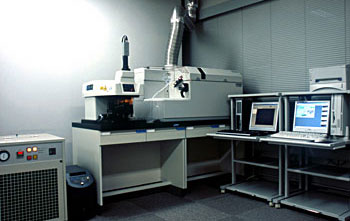|
||||||||||||||||||||||||||||||||||||||||||||||||||||||||||||||||||||||||||||||||||||||||||||||||||||||||||||||||||||||
| Abstract We studied origin determination of natural unheated blue sapphire using LA-ICP-MS analysis. The study proved that blue sapphires of non-basaltic origin from Madagascar and Sri Lanka, which were quite difficult to be distinguished from each other by traditional methods (such as observation of internal features, spectroscopic analytical method or trace-element analysis by X-ray fluorescence analytical method), could be clearly distinguished. That means, Sn (tin) and Ta (tantalum) were detected in the order of ppm in the stones from Madagascar while those elements in the stones from Sri Lanka were under detection limit. Introduction Geographical origin determination of a gemstone does not indicate quality or value of the gemstone and should be regarded as an opinion proposed by the gemmological laboratory that identifies its origin. CIBJO regulations also have this philosophy as its basic principle. On the other hand, origin determination of a gemstone sometimes poses importance archeologically, and is one of information that jewellers are anxious for in their daily trades. Different origin determination on a single stone by different laboratories will bring on confusion among customers, and this may eventually reduce trust in laboratories. Therefore, origin determination should be made on more sophisticated scientific basis. Origin determination of a gemstone has focused mainly on observation of internal features. Spectroscopic analysis and measurement of impurity elements by X-ray fluorescence provide us important clues in searching for origin determination of a gemstone. With these methods, determination of occurrence, that is, distinction between basaltic origin (for instance, from Australia, China or Thailand) and non-basaltic origin (from Sri Lanka, Myanmar or Madagascar for instance), are easy. However, distinction between origins within the similar occurrence, such as between Thailand and Australia, or Madagascar and Sri Lanka, are difficult. Especially after late 1990�s when blue sapphires from Madagascar came into fashion in the gem market, distinction between blue sapphires from Madagascar, where is rather new origin, and those from Sri Lanka, where is a traditional origin, often raises problem in the industry. What is LA-ICP-MS? LA-ICP-MS is a method to quantitatively and qualitatively analyse constituents of a sample by detecting a mass of grains, which were vaporised and dispersed when the sample was irradiated by high-energy laser beam of shorter wavelength on its surface, and then ionised by plasma generated by high-frequency power. This has a feature of rapid detection in minute amounts from ppb to ppm level (a billionth to a millionth) on wide range of elements from a light one He (helium) to a heavy one U (uranium). Such characteristics make the equipment draw attention from the most advanced industrial field as the most effective method to analyse minute amount of impurity constituents. A sample chamber does not need to be vacuumed in this analysis, and local analysis on a specific area is possible with its narrow laser beam and a CCD camera equipped. The measurement can be done regardless condition of a sample when using the fourth high frequency (266nm) and the fifth high frequency (213nm) of Nd-YAG laser or using excimer laser (193nm) which can vaporise and evaporate all the samples. However, a jewellery to be tested must be vaporised and evaporated in a local area (100��? at minimum) to be induced to ICP-MS. Study of origin determination by compositional analysis and trace element analysis of gem minerals using LA-ICP-MS analytical method is growing recently and trace elements such as Ti, Fe, V, Cr, Fe and Ga, which are originally contained in natural sapphire or ruby, have been analysed by Gunther (2001), S. Saminpanya (2003) or A.H. Rankin (2003), who advocate chemical finger printing. Samples and measurements �@�@The MODEL UP-213A/F of NEW WAVE RESEARCH and the 7500a of AGILENT were used for laser ablation system and ICP-MS respectively in this study (Fig-1). Quantitative analysis was made in this study by calculating a concentration conversion factor on each element to be measured, because on LA-ICP-MS, quantitative analysis by calibration curve method is difficult. Standard sample NIST612 glass was used to calculate a concentration conversion factor, which was used together with a data obtained by analysing the actual sample, in order to calculate a quantitative value of the actual sample. After the operation of the system, a trace is left on a stone surface. Analysis sensitivity is raised when the amount of vaporised and evaporated substance increase, but after research we decided to adopt a method to inscribe our laser mark "GAAJ" on the girdle so that it can fulfil the condition of obtaining stable sensitivity for light elements with the least trace, as well as the mark proves the test has been carried out (Fig-2). This laser mark is, like a laser inscription currently performed on diamonds, in the size you can barely see under a 10X loupe without damaging beauty of a gemstone. The width of the laser line is 16��m, and the size of the mark is 80�~230��m with the depth 1�`3��m. Conditions used for this study are indicated on Table-1. The test was carried out three times with laser pulse high frequency 20Hz, laser energy 0.038mJ, elapsed time 0.01 sec and measurement time 40 sec. �@�@Subject for this study were fifteen stones from Madagascar and ten stones from Sri Lanka which were unheated and produced from the similar metamorphic rock with non-basaltic origin (Fig-3). Also blue sapphires of basaltic and non-basaltic origin from other localities were measured for comparison with the subject stones. The details of the samples are shown in Table-2.
back)
back
back
|
||||||||||||||||||||||||||||||||||||||||||||||||||||||||||||||||||||||||||||||||||||||||||||||||||||||||||||||||||||||
|
||||||||||||||||||||||||||||||||||||||||||||||||||||||||||||||||||||||||||||||||||||||||||||||||||||||||||||||||||||||







